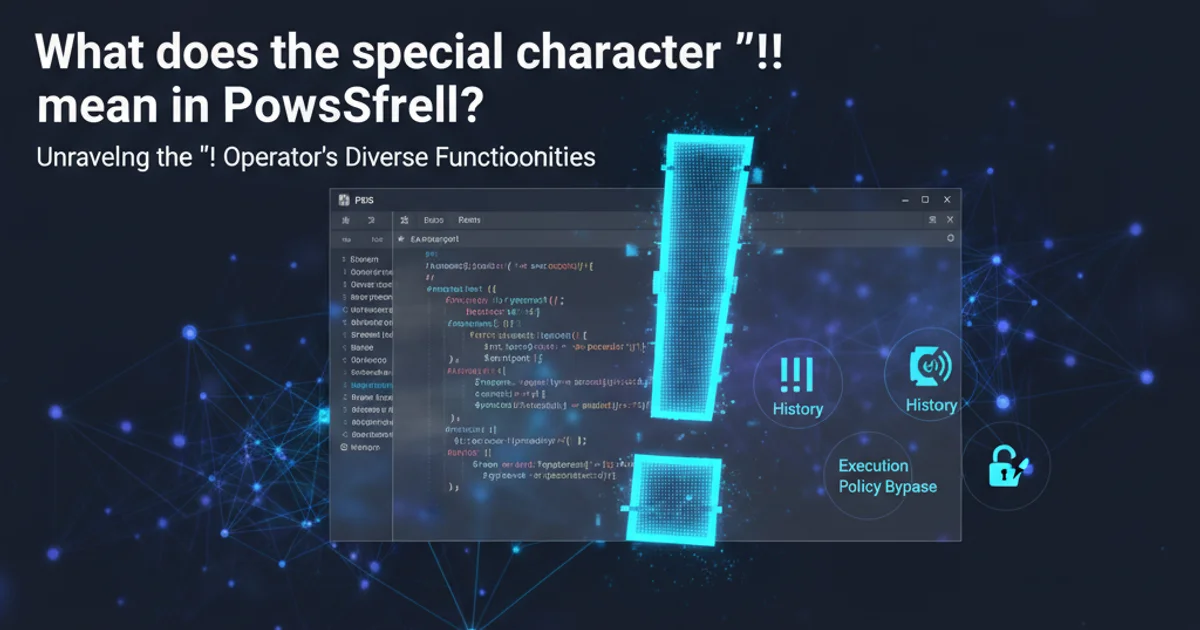What does the special character "!" mean in PowerShell?
Categories:
Unraveling the '!' Special Character in PowerShell

Explore the various meanings and uses of the exclamation mark (!) in PowerShell, from logical negation to history expansion and more.
The exclamation mark (!) is a seemingly simple character, yet in PowerShell, it carries multiple significant meanings depending on its context. Understanding these different roles is crucial for writing effective and concise PowerShell scripts. This article will delve into the primary uses of ! in PowerShell, including logical negation, history expansion, and its role in specific operators.
Logical Negation: The 'NOT' Operator
The most common use of the exclamation mark in PowerShell is as the logical negation operator, equivalent to the -not operator. It reverses the boolean value of an expression. If an expression evaluates to $true, ! makes it $false, and vice-versa. This is fundamental for conditional logic and filtering.
$true
!$true
$false
!$false
$a = $null
if (!$a) {
Write-Host "`$a is null or false"
}
$b = "Hello"
if (!($b -eq "World")) {
Write-Host "`$b is not 'World'"
}
Examples of logical negation with the '!' operator.
! is concise, -not is often preferred for readability, especially in complex expressions. Choose the style that best balances brevity and clarity for your team.History Expansion (PSReadLine Module)
When the PSReadLine module is loaded (which it is by default in modern PowerShell versions), the ! character takes on a powerful role in command history expansion, similar to bash. This allows you to re-execute or manipulate previous commands quickly. This functionality is primarily interactive and less common in scripts.
flowchart TD
A[User types '!' in console] --> B{Is PSReadLine loaded?}
B -->|No| C[Literal '!' character]
B -->|Yes| D{Followed by command number or string?}
D -->|No| C
D -->|Yes, number| E[Execute command from history by number]
D -->|Yes, string| F[Execute last command starting with string]
F --> G{No match?}
G -->|Yes| H[Error: Event not found]
G -->|No| F_1[Execute matched command]Decision flow for '!' in PowerShell history expansion.
# Assuming PSReadLine is loaded
# Type these commands one by one:
Get-Process
Get-Service
Get-ChildItem
# Re-execute the last command (Get-ChildItem)
!!
# Re-execute the command starting with 'Get-P'
!Get-P
# Re-execute the 2nd command in history (Get-Service, if it was the 2nd)
!2
Interactive examples of history expansion using '!'.
PSReadLine module, not core PowerShell. If PSReadLine is not loaded or disabled, ! will simply be treated as a literal character or a logical negation operator, depending on context.Other Contexts: Not Equal (-ne) and Not Like (-notlike)
While ! itself is not part of these operators, it's important to note that PowerShell uses other operators that incorporate the concept of 'not' or 'negation'. The -ne (not equal) and -notlike (not like) operators are common examples, providing specific negation functionalities for comparison and pattern matching.
$a = 10
$b = 20
# Not Equal
if ($a -ne $b) {
Write-Host "`$a is not equal to `$b"
}
$string = "Hello World"
# Not Like (pattern matching)
if ($string -notlike "*PowerShell*") {
Write-Host "String does not contain 'PowerShell'"
}
Examples of -ne and -notlike operators.